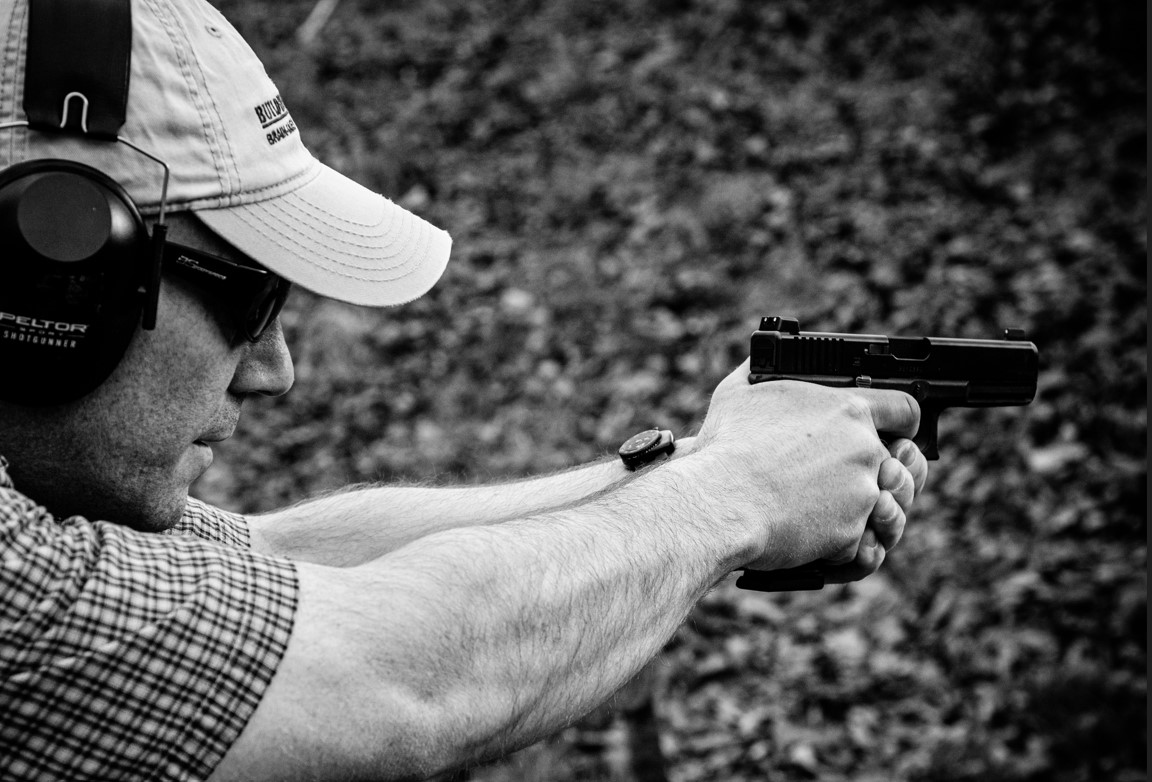Article 065 – Stop Teaching Drawstroke First
Most agencies start by teaching recruits to draw from the holster. This corrupts shooting mechanics—and most officers never recover.
Almost every law enforcement agency in the country starts new recruits out with firearms training by giving them a duty holster and handgun (simulated or real), then asking them to practice drawing from the holster.
In some cases, this is done without ANY instruction provided on how to accomplish this task at all. In many cases, this is done prior to recruits attending the academy and in almost all cases this is literally the first exposure to firearms training new police recruits have ever had.
This means that teaching the draw is done before the trainees know (by which we mean possess the ability to perform with unconscious competence) how to properly grip and control a pistol during recoil.
What is the end result? It is not just bad shooters. Often, it is unfixably bad shooters.
Does this mean it is impossible for these students to recover? Of course not. But most of them will not.
With very few exceptions it is literally impossible for the agency to fix them after this training practice is applied. The resources necessary to do so simply don’t exist. Those who recover must do so on their own time, and their own dime.
Enough already. Stop the insanity!
This is not to say that the instructors and programs who do this are not well-intentioned. Most of them are, so let’s look at why this is such a problem and what can be done instead.
Using a very broad brush here, the general idea being applied is that repetition is what creates competency and therefore increasing repetition and “priming” students before they go to the range for live fire training is beneficial to them.
The underlying thoughts and intentions are good, but they are missing some key elements related to shooting mechanics, learning, and motor skill performance.
First, if you have not read it, please take a few minutes to read our previous article about learning in range environments where we draw a distinction between repetition and iteration.
When it comes to developing specific skills, it is iteration, not merely repetition that produces effective learning. This involves more than rote performance. It also requires specific intent and continual feedback. These elements are sorely lacking with self-directed student practice in a very general skill area with no assigned performance metrics or meaningful process of evaluation applied.
“Having the written material plus seeing the methodology and technology on the range along with hearing Dustin present the nuances of the material really helps paint the picture of how we should all be presenting firearms training for those who have signed up to protect their communities.”
-John Baggett, Rangemaster, Central Alabama Sheriff’s Office with 200+ personnel
Course Announcement!
Nashville, TN July 24-25, 2024
This Course Date is Open to Civilians
Understanding the Terrain: An Overview of Brain-Based Tactical Training Design (2 Day)
Second, it is important to understand that merely operating a firearm and related kit does not require any firearm-specific skills.
Read that previous sentence again.
Guns are very easy to operate. They are very difficult to operate well.
Pretty much any person can pick up a pistol and fire it. Even small children can (and do) often accomplish it unsupervised the first time they try (far too frequently with lethal results).
We can operate firearms using the same basic gross motor control programs that we would use to operate, say, a beer can. In fact, there are entire methods of firearms training that are based upon leveraging this fact (e.g., “kinesthetic” shooting methods).
When the expectations of performance are low (as they are in most armed professional applications) or even non-existent (as they are many “combat shooting” range training settings) then these gross motor skills can be “adequate” to participate, pass training, and qualify.
Students mostly don’t need to learn gun-specific motor skills—so why would they ever do it? Referring back to our earlier article about range training, how could they even do so? The training environment and range processes used make this all but impossible.
Third, it is important to understand the harmful impacts of what we call progressive interference. This earlier article provides a detailed explanation of this term.
The drawstroke is a complex skill. There are many subskills involved, including visual processing and decision-making, defeating holster retention, assuming a shooting grip, snatch, movement and placement of the support hand, assumption of a two-handed grip during presentation, the hand, arm, head, and body mechanics of the presentation itself, more visual processing and visuo-motor skills related to both the sighting system and the subject (target). And, let’s not forget the management of the trigger finger and trigger itself.
The performance elements of none of these sub-skills matter much if the objective is simply to launch rounds (i.e., achieve “combat accuracy” on a non-moving paper silhouette) at close range (e.g., 3 yards). They matter even less if the objective is simply to just get the weapon out of the holster and pointed in a general direction within a specified timeframe, and even less still if there isn’t any standard of performance applied at all. In these cases, those subskills can all be adequately performed using pre-existing gross motor programs.
When this is done repetitively, using these non-gun-specific motor programs become how the brain and body have learned to accomplish the task of drawing—and all of the related sub-tasks involved, including gripping and firing the pistol. This works. It does not work well.
In other words, this practice builds poor shooting mechanics—right from the outset.
The author was invited to conduct an audit of a large law enforcement academy firearms program several years ago. Due to some logistics and scheduling issues, the audit started on the second week of training, after handgun training was completed.
The first day of the audit, the author called the lead instructor to the side of the range and pointed out that approximately 95% of the students had a visible-at-distance gap between the webbing of the shooting hand and the beavertail of the pistol when in a two-handed shooting position. Almost the entire class had a severe (and by that point more-or-less permanent) limitation in their capability to manage recoil effectively, after the agency provided handgun training was completed.
Starting with drawstroke—and having the recruits practice it on their own prior to actually learning how to shoot—is by no means the only cause of this mechanics issue, but it is a significant (and extremely common) contributing factor.
If your agency is taking this approach, allow us to suggest that you’re not doing your recruits any favors. In fact, you’re screwing them over.
We suggest a different approach.
"Enables all new methods of range control."
“We just completed our first full-length police recruit academy firearms training using NURO. We have also been using it for our in-service training to create flexible, cost-effective decision making and skill performance scenarios. Static range drills, repetitive qualification, and pre-defined field courses that don’t scale are the past.”
-Brandon P., Armament Section Head, Syracuse, NY Police Department

"A revolutionary training system."
“I believe NURO will revolutionize the firearms training industry and inform future best practices for use-of-force training. It will fundamentally change how these skills are developed, practiced and tested…NURO is the future of the firearms training industry.”
–John Holschen., Heiho Consulting Group, Founder and Principal Consultant
Two of the core precepts of brain-based training design are:
1) the subcomponents of more complex skills must be consolidated (stored in the brain’s long-term memory) before they are combined into more complex skill performance and,
2) the limits of the brain’s short-term memory system (which new information must pass through before it can be stored in long-term memory) must be considered during training design and delivery.
If these parameters on the brain’s ability to learn are not considered, then significant amounts of time and other resources like ammunition and instructor availability are quite literally wasted. They are expended without any potential for producing learning.
With these issues in mind, we instead suggest breaking down the core shooting mechanics. We define these (in no particular order) as vision (aiming), vision (subject and situational awareness), structure / recoil management, and trigger management.
The students must learn (note that this is different than “the instructors must present”) through iterative repetition that occurs over time. During this process, instructors must be careful not to exceed the capacity of the students’ brains to acquire new information.
This may appear as if we are suggesting basic “marksmanship” training—but it should be much more than that, at least as this term is normally defined and understood.
Too often the foundational skills for firearms use are taught in such a way that they become utterly irrelevant for gunfighting. This failure is even embedded in much of the common language currently used within the industry, e.g., “Marksmanship” vs. “Combat Shooting.”
This establishes a framework that leads many in the industry to a false choice, and a stupid one at that.
Setting aside some domestically irrelevant infantry combat applications, what combat shooting doesn’t require hitting? The fact is that all combat shooting requires some degree of marksmanship and that combat-relevant marksmanship requires all four of the shooting mechanics areas to performed adequately, as defined by the task requirement.
A student can’t practice aiming and trigger management in the absence of fighting structure and situational awareness and expect that any resulting skills will somehow transfer to gunfighting. They probably won’t.
It’s no mystery why law enforcement officers miss their intended target more than 70% of the time they fire their weapons for real. Most have never even been asked to use all of these shooting mechanics at the same time before, much less developed them into a functional skillset.
What we’re promoting is the development of combat-relevant shooting skills, including grip, various elements of vision, recoil management, and follow-through before moving on to—in particular—drawing from the holster.
Why? Because drawing from the holster requires the student to do all of those other skills—whether they know how to or not.
If the student has acquired and consolidated (put into long-term memory) those other skills, learning the draw is an opportunity to practice and improve them. We call this progressive reinforcement.
If the student has NOT learned those other skills yet, they will still do them when they draw from the holster. This is unavoidable. But if they don’t know how to do them right, how can they possibly do anything other than practice doing them wrong? This, in a nutshell, is progressive interference.
Law enforcement agencies in particular are almost always challenged by limited time and access to resources.
Given this unavoidable fact they should stop doing things that waste time, reduce resource efficiency, and irreparably harm the performance potential of new officers.
Please, stop teaching drawstroke first.
"Stands out as an embodiment of neuroscience-driven methodologies. It is the future of tactical training."
-Justin Smith, Ph.D., Founder, Tactical Neuroscience



